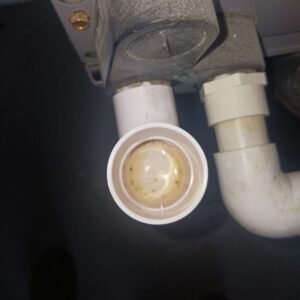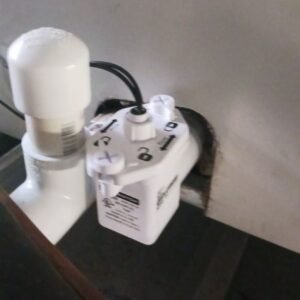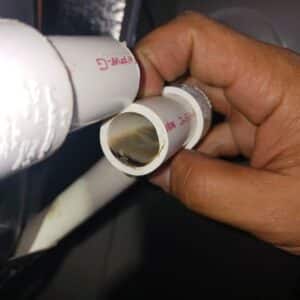The AC Float Switch: An Unsung Hero in Your HVAC System
Air conditioning is a modern comfort that most of us take for granted, but maintaining an efficient and healthy HVAC system is vital to keeping our homes comfortable and safe.
One lesser-known but essential component of an air conditioning system is the AC float switch.
In this blog, we’ll explore what an AC float switch is, its purpose, and why it’s crucial for your system’s functionality and safety.
What is an AC Float Switch?
An AC float switch, also known as a condensate float switch or safety switch, is a small device typically installed in the drain pan of your air conditioning unit.
Its primary purpose is to monitor the water levels produced as condensation and prevent any potential overflows, which can lead to water damage and mold growth.
The switch works as a safety mechanism, shutting off the system if water levels rise too high.
How Does an AC Float Switch Work?
To understand the function of the AC float switch, it’s crucial to grasp the basics of an air conditioning system.
When an air conditioner is in operation, it cools the indoor air by removing heat and humidity.
This process generates condensation, which is collected in a drip pan or condensate drain pan.
From there, the water is drained away from the unit through a drain line.
The AC float switch is strategically positioned in the drain pan to monitor the water level.
The switch itself comprises a buoyant float connected to an electrical circuit. As the water level in the pan rises, so does the float.
If the water reaches a predetermined level, the float triggers the switch, which then breaks the electrical circuit and shuts down the air conditioning system.
This action prevents any further condensation from entering the pan and stops the system from potentially causing water damage.
What does a float switch look like?
A float switch is a small white PVC cup with 2 black wires sticking out. If your system is horizontal in the attic, it should have 2 float switches, one connected to the unit and one on the secondary drain pan. They typically has two main components:
- Buoyant float: This part of the float switch is designed to float on the surface of the water in the drain pan. It is usually a small, cylindrical, or spherical piece made of plastic or another buoyant material. In some designs, the float may be shaped like a doughnut, with a central hole that fits around a vertical rod connected to the switch mechanism.
- Switch mechanism: The switch mechanism is connected to the buoyant float, either directly or via a rod or lever. This part of the float switch contains electrical contacts that open or close the circuit depending on the water level. The switch mechanism is usually encased in a plastic or metal housing to protect it from water and debris.
Float switches can come in various designs and sizes, but their essential function and appearance are generally similar across different HVAC systems.

Why is an AC Float Switch Important?
- Preventing water damage: The primary function of the AC float switch is to prevent water damage resulting from an overflowing drain pan. Water damage can not only be expensive to repair, but it can also cause structural issues, destroy valuable belongings, and create a breeding ground for mold and mildew.
- Mold prevention: Excessive moisture, particularly in dark and hidden spaces such as the area around the AC unit, can lead to the growth of mold and mildew. Mold can pose severe health risks, particularly for individuals with allergies, asthma, or compromised immune systems. By ensuring that the water in the drain pan is adequately managed, the AC float switch helps prevent mold growth.
- Maintaining efficiency: An air conditioning system that’s shut down due to an activated float switch is a clear indication that something is amiss. This could be as simple as a clogged drain line or as complex as a damaged evaporator coil. By shutting down the system, the AC float switch forces homeowners to address the issue, ultimately maintaining the efficiency and longevity of their HVAC system.
- Cost savings: An AC float switch can help save money in the long run by preventing costly water damage repairs, mold remediation, and potential system breakdowns.
Is a float switch supposed to have water in it?
A float switch itself is not supposed to have water inside it, but it is designed to monitor the water level in the condensate drain pan. The purpose of the float switch is to detect when the water level in the drain pan becomes too high, which can indicate issues such as a clogged drain line or an overflowing drain pan. When the float switch detects excessive water levels, it activates and interrupts the electrical circuit, causing the air conditioning system to shut down as a safety measure.
The float switch typically has a buoyant component that floats on the water in the drain pan. When functioning correctly, the float will move up and down with the water level, but the switch itself should remain dry and free from water infiltration. If you find water inside the float switch, it could indicate a malfunction or a compromised seal, which may require repair or replacement.

Why does my AC safety float switch keep tripping?
If your AC safety float switch keeps tripping, there may be several underlying issues causing the problem. Here are some common reasons:
- Clogged drain line: A clogged drain line is one of the most common causes of a tripping float switch. When the condensate cannot drain properly, the water level in the drain pan rises, triggering the float switch to shut down the system. Debris, dirt, mold, or algae can cause a blockage in the drain line.
- Dirty or frozen evaporator coil: A dirty or frozen evaporator coil may produce excessive condensation that the drain pan cannot handle, leading to the float switch being tripped. Regular maintenance and cleaning of the evaporator coil can help prevent this issue.
- Damaged or misaligned drain pan: A damaged or misaligned drain pan may not collect and drain condensation properly, causing the water level to rise and trip the float switch. In this case, the drain pan may need to be repaired or replaced.
- Improper float switch installation: If the float switch is not installed correctly or at the correct height, it may trip too easily. A professional HVAC technician can inspect and adjust the installation if needed.
- Malfunctioning float switch: A faulty or failing float switch can trip even when the water levels in the drain pan are normal. In such cases, the float switch may need to be repaired or replaced.
To resolve the issue of a repeatedly tripping AC float switch, it’s essential to diagnose the root cause and address it. Regular HVAC system maintenance can help prevent these issues, but if the problem persists, consult a professional HVAC technician for assistance.
How do I reset my AC float switch when full of water?
Resetting your AC float switch is a relatively simple process, but always exercise caution when working with electrical components. Here are the steps to reset your float switch:
- Turn off the power: Before performing any work on your HVAC system, always start by turning off the power to the air conditioning unit. You can do this by switching off the breaker in your electrical panel that corresponds to the AC system.
- Locate the float switch: Find the float switch in the drain pan of your indoor air handler unit. It’s typically a small device with a buoyant float connected to it.
- Check for water in the drain pan: If there is standing water in the drain pan, this likely indicates a clogged drain line. Remove the water using a wet-dry vacuum or towels, and then proceed to clear the drain line using a wet-dry vacuum or by pouring a mixture of warm water and vinegar down the drain.
- Inspect the float switch: Check the float switch for any visible damage or debris that may be causing it to malfunction. Clean it gently if necessary.
- Reset the switch: Depending on the design of the float switch, resetting it may involve pushing the float back down manually or pressing a reset button on the switch itself. Ensure the float moves freely and is not obstructed.
- Turn the power back on: After resetting the float switch, turn the power back on at the breaker panel. The AC unit should now operate normally.
If your float switch continues to trip or the issue persists, it’s best to consult a professional HVAC technician to diagnose and fix the problem. Regular maintenance can help prevent such issues and keep your AC system functioning optimally.
How much does it cost to install an AC float switch?
The cost of installing an AC float switch can vary depending on several factors, such as the type of float switch, your geographic location, and the labor rates charged by HVAC professionals in your area.
On average, the cost of a float switch itself ranges from $20 to $60, depending on the brand and model.
Labor costs for installation by a professional HVAC technician can range from $50 to $150 per hour.
Typically, installing a float switch takes around 1 to 2 hours, which means the total cost for parts and labor could range from $180 to $300.
However, it’s essential to get a personalized quote from a local HVAC professional, as costs can vary greatly depending on your specific situation. It’s also worth noting that installing a float switch may be part of a broader HVAC system maintenance or repair service, so the cost may be bundled with other services, such as cleaning the evaporator coil or inspecting the entire system. If you are a member of the Therapy Maintenance Plan, you get a float switch for FREE!

Can you replace a float switch? DIY
Yes, you can replace a float switch if it is malfunctioning or damaged. Replacing an AC float switch typically involves the following steps:
- Turn off the power: As always, start by turning off the power to the air conditioning unit at the breaker panel to ensure your safety while working on the system.
- Locate the old float switch: Find the float switch in the drain pan of your indoor air handler unit. It’s usually a small device with a buoyant float connected to it.
- Remove the old float switch: Disconnect the electrical wiring and carefully remove the old float switch from the drain pan. Make sure to note how the wiring connections were made, as you’ll need to replicate these with the new float switch.
- Install the new float switch: Attach the new float switch to the drain pan in the same position as the old one. Make sure it is installed at the correct height to properly monitor the water level in the drain pan.
- Reconnect the wiring: Connect the electrical wiring to the new float switch, replicating the wiring connections from the old switch.
- Test the new float switch: Turn the power back on at the breaker panel and test the new float switch to ensure it is functioning correctly. You can do this by manually raising the float to see if it shuts down the AC system as intended.
While these are general steps, the specific process for replacing a float switch may vary depending on the make and model of your HVAC system. If you’re unsure about any part of the process or prefer a professional to handle the replacement, it’s best to consult a qualified HVAC technician.
Will the float switch turn off the thermostat?
A float switch will not directly turn off the thermostat itself, but it can interrupt the operation of the air conditioning system. When the float switch is triggered due to a high water level in the drain pan, it breaks the electrical circuit to the air handler or the outdoor compressor unit, effectively shutting down the air conditioning function.
However, the thermostat will still display the temperature settings and may continue to control other aspects of your HVAC system, this is if the thermostat has a battery. If the thermostat gets power from the common wire the thermostat will turn off.
In essence, the float switch serves as a safety mechanism to prevent water damage and other issues by stopping the cooling function when there’s a problem with condensation drainage. While the thermostat remains on with battery and is operational, you’ll notice that the air conditioning system is not cooling your home until the issue causing the float switch to trip is resolved.
Why does my AC keep filling up with water?
If your air conditioning unit keeps filling up with water, there could be several reasons behind the issue. Here are some common causes:
- Clogged drain line: One of the most frequent reasons for water buildup in an AC unit is a clogged drain line. Dirt, debris, mold, or algae can accumulate in the line, preventing proper drainage of the condensate.
- Dirty air filter: A dirty or clogged air filter can restrict airflow over the evaporator coil, causing it to become too cold and freeze. When the ice on the coil eventually melts, it can produce excess water that the drain pan cannot handle, leading to water accumulation.
- Frozen evaporator coil: A frozen evaporator coil can result from low refrigerant levels, a dirty coil, or insufficient airflow. When the ice on the coil melts, it can cause water to overflow in the drain pan.
- Damaged or misaligned drain pan: A cracked, damaged, or misaligned drain pan may not collect and drain condensation properly, leading to water buildup in the AC unit.
- Malfunctioning condensate pump: If your AC system relies on a condensate pump to remove the water, a malfunctioning or broken pump can cause water to accumulate.
- High humidity: Excessively high indoor humidity levels can cause your AC to produce more condensation than the system is designed to handle, resulting in water buildup.
To address the issue, you’ll need to identify the root cause and take appropriate action, such as cleaning the drain line, replacing the air filter, or fixing the drain pan. In some cases, you may need to consult a professional HVAC technician to diagnose and resolve the problem. Regular maintenance can help prevent water buildup issues and keep your AC system functioning efficiently.

Embracing the Benefits of AC Float Switches with Therapy Maintenance Plans
The AC float switch is a small yet essential component of your air conditioning system.
By monitoring the water levels in the condensate drain pan and shutting down the system when necessary, it prevents water damage, mold growth, and maintains the overall efficiency and safety of your HVAC system.
While it may be an unsung hero, the AC float switch plays a critical role in protecting your home and ensuring a comfortable living environment.
As a homeowner, it’s crucial to understand the importance of regular HVAC maintenance, which includes checking the AC float switch and the drain pan for proper functioning. To make this process hassle-free, consider subscribing to the Therapy Maintenance Plans, a monthly subscription that provides yearly maintenance, exclusive discounts, and other benefits such as free float switch replacements.
Regular inspections, cleaning, and maintenance by a qualified HVAC technician from The AC Therapist can help identify potential issues before they become more significant problems. This proactive approach can save you money on repairs, extend the life of your air conditioning system, and ensure a healthier, more comfortable home.
In summary, never underestimate the importance of the AC float switch in your air conditioning system. Keep an eye on its performance and ensure that it is well-maintained with the help of Therapy Maintenance Plans. By understanding the role of this small but essential component, you can contribute to the efficiency and longevity of your HVAC system and enjoy a comfortable, safe living space.








